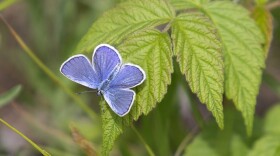A prescribed burn was held in a portion of the Albany Pine Bush Preserve Thursday. It was the first time conditions allowed preserve staff to set the fire in the month of February.
The Pine Bush Preserve is known for its unique landscape and is a habitat to rare and endangered plants and animals, including the Karner Blue Butterfly.
On a not-so-typical balmy February afternoon, Albany Pine Bush Preserve Commission Conservation Director Neil Gifford points to a large grassy, shrubby area tucked between suburban homes.
“Fire is critical to the plants and animals that are here,” said Gifford. “And we would not have this habitat and we wouldn’t have such an incredible diversity and large populations of some very rare plants and animals here without fire.”
Gifford says indigenous people maintained the land with fire for thousands of years. Today, the Commission uses it to provide native plants and animals crucial habitat.
“We burn within a very narrow window of environmental conditions. And one of the many complicating features of climate change is the conditions are no longer as predictable as they used to be,” said Gifford.
Gifford says prescribed burns like these are usually done in the late fall or early spring, when plants are dormant. And today, with clear skies, a light breeze, and little snow on the ground, the timing is right — albeit several weeks early.
“Given the changing conditions, we’ve realized, that when we get conditions that are in prescription, we really need to get out and try to burn areas that need it,” said Gifford.
APBPC Fire Manager Tyler Briggs is the day’s burn boss. He rides up on an ATV as plumes of white smoke billow from behind a ridge.
“We have really, really calm light winds today. And that’s what we want, because we want the smoke to go aloft and disperse above smoke-sensitive areas,” said Briggs. “Everything is going pretty mellow and nice, now. You’ll see when the igniters make it down this way, but we already created the black line downwind.”
This area of the preserve has had non-native plants and trees removed, giving way for native species.
As a line of orange flames approaches, Gifford is showing me some plants that will benefit from the fire. A small pitch pine at the edge of the trail was brought here because of fire – the pine’s cones only open when heated by fire.
“This little pitch pine tree is maybe eight years old and resulted from removing the black locust, opening the canopy up, and providing seeds a place to land,” said Gifford.
In just a few minutes, the fire reaches the edge of the first burn phase.
Patrick Donavan is volunteering today, using an igniter to start fires – a container filled with a mixture of gasoline and diesel fuel with a lit wick on the end.
“It has a cotton wick, so the way it works is a little bit of the fuel comes out here, wets the wick, and then the wick is what is on fire and sets the fuel on fire, and that’s how we put fuel on the ground. But it’s only one of many tools that we’ll use,” said Donavan.
This burn is a collaborative effort between the Albany Pine Bush Preserve Commission, the New York State Department of Environmental Conservation, New York State Parks, and the Nature Conservancy.
As the edges of the field smolder and crackle, burn boss Briggs is pleased with the results so far in the first prescribed burn of the year.
“I’m really happy with the way this first unit burned. And it’s a good chance for us to watch the smoke column before we move into this unit, which is in a tighter pocket,” said Briggs.






